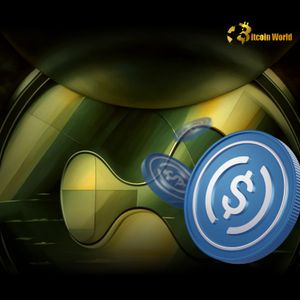Interview | Tokenized RWAs could hide the next financial crisis, warns MEXC exec
7 min read
Real-world assets hide a hidden risk that could recreate the 2008 subprime mortgage crisis, warns Tracy Jin of MEXC. Real-world asset tokenization has become one of the fastest-growing segments in the crypto space. The overall value of tokenized assets reached over over $23 billion in 2025, up from $1 billion in 2021. These assets include gold, real estate, securities, treasuries, fine art, and more. The goal of tokenization was to make these types of assets more accessible and transparent to average traders. However, while accessibility has improved, there is a distinct lack of transparency, with many RWAs issued on private blockchains. This creates a real risk of institutions packaging high-risk assets into RWAs, exposing holders to major losses, according to Tracy Jin, COO of MEXC exchange. In an interview with crypto.news, she warned that this lack of transparency could spark a 2008-style financial collapse, threatening both the crypto space and broader financial markets. crypto.news: Can you give a real-world example of an RWA that seemed safe on-chain but turned out to be financially dangerous? TJ: In the early days of real-world asset tokenization, some DeFi protocols. such as those built on Centrifuge, allowed issuers to tokenize portfolios of receivables, like unpaid invoices from small and medium-sized businesses. These tokenized assets were then used as collateral for borrowing stablecoins on platforms like Tinlake or MakerDAO. A clear pattern of this risk has emerged from early DeFi lending protocols that issued on-chain credit backed by opaque, off-chain assets, such as a portfolio of “future receivables” from small business loans. On-chain, everything looks perfect. An investor sees a token representing a claim on a diversified loan pool that is generating a steady, high yield. The smart contracts function flawlessly, and interest payments are distributed on time. The hidden danger is the real-world credit quality. The on-chain token cannot reveal if the small businesses in the off-chain portfolio are struggling or beginning to default. When an economic downturn hits and those real-world businesses fail, the “receivables” backing the token evaporate. Suddenly, the “safe” high-yield asset is revealed to be backed by a pile of defaulted debt, and the token’s value collapses toward zero. This exact scenario, where immaculate on-chain data masks a rotten off-chain foundation, is the template for how a seemingly safe RWA can become financially dangerous overnight. CN: You’ve called toxic tokenization a hidden risk—how can the average investor tell a “toxic” RWA from a legitimate one? TJ: Toxic tokenization occurs when a flawed off-chain asset, one that is opaque, overvalued, or has an unenforceable legal claim, is hiding behind a high-tech token. This is marked by how its on-chain data looks perfect, but it completely obscures the rot in the real-world foundation. In order to tell them apart, an investor must look past the token and apply traditional due diligence. As an investor, the first step is to verify the issuer and the custodian and check who these real-world entities are. A legitimate RWA will only be managed by a known, regulated firm with a public reputation. If the investor couldn’t find information about the team or custodian, it’s best to avoid the project as a risk calculation move. Next, an investor must demand real proof and legal clarity. A legitimate project is supported by regular, independent audits from reputable accounting firms, not just a simple on-chain dashboard. The legal structure must also be clear: does owning the token give you a direct, enforceable ownership right to the asset? If the path to redeeming your asset in a crisis is vague, the token is likely toxic. Finally, one must assess the real-world liquidity of the underlying asset. Tokenizing an illiquid item doesn’t magically create a deep market for it. If the issuer, the audits, the legal claim, and the underlying market aren’t all crystal clear, the average investor should treat the RWA with extreme caution. You might also like: Escaping the extraction economy: Ownership and RWAs win | Opinion CN: Is tokenizing real estate or fine wine inherently risky, or is the danger more about who is doing the tokenizing and how? TJ: The inherent market risk of assets like real estate or fine wine is well-understood and has been managed for centuries. The true, amplified danger comes almost entirely from the tokenization process itself, which involves the who behind it, and how they are doing it. Ironically, this new technological layer introduces multiple novel points of failure. The most significant risks are operational and legal. An unscrupulous issuer can use an opaque valuation to tokenize a property at an inflated price, selling fractions to investors who are immediately at a loss. The physical asset or its legal deed could be stored with an incompetent or fraudulent custodian, where it could be lost, sold, or seized, rendering the tokens worthless. Furthermore, a bug in the smart contract code could also lead to a complete loss of the digital representation of the asset. The legal framework is also a complex patchwork, making it difficult to enforce ownership rights across different jurisdictions. Because of this, the quality, regulation, and technical competence of the issuer and its partners are far more critical risk factors than the market fluctuations of the underlying asset. CN: Why are institutions using private blockchains for RWAs, and how does that undermine the transparency blockchain promises? TJ: Institutions are flocking to private or permissioned blockchains because they are united behind one reason: taking control. For a highly regulated bank, the core features of a public blockchain like Ethereum (ETH), with open access and censorship resistance, are bugs, not features. Their entire business model is built on adhering to strict KYC/AML compliance and maintaining client confidentiality. A private blockchain allows an institution to build a walled garden. They can control exactly who is allowed to join the network, ensuring every counterparty is known and vetted. This allows for privatizing transaction details and amendment power or transaction reversal if there’s an error or if it’s a court order. This level of control is a non-negotiable requirement for them. While this approach uses blockchain technology to improve back-office efficiency and settlement times, it fundamentally undermines the core ethos of decentralized, public transparency. The ledger is only “transparent” to the select group of permissioned participants. It’s an efficiency play that recreates the closed model of traditional finance, not a philosophical leap toward a more open and equitable system. You might also like: Five verification needs when tokenizing RWAs | Opinion CN: Do you believe large financial players are intentionally offloading bad assets on-chain, or is it more about a lack of oversight? TJ: At this early stage, I believe it’s less about a deliberate conspiracy from major players to offload “toxic waste” and more about a combination of opportunistic experimentation and a systemic lack of oversight. Top-tier institutions are treading very cautiously, primarily on private blockchains, because their reputations are on the line. The more immediate danger comes from lower-tier financial firms or unregulated entities that see tokenization as a form of “regulatory arbitrage.” They might be tempted to package higher-risk assets, like subprime loans, and sell them to a global crypto retail audience that lacks the tools for deep due diligence. This isn’t necessarily offloading assets they know are worthless, but rather misrepresenting the risk to chase demand. The core issue is a failure to price risk correctly. In a market driven by the chase for high yield, an RWA’s true risk profile can be obscured. Investors might buy a tokenized B-rated loan that’s paying a high APY without realizing the underlying danger. It is less about intentional malice from big banks and more about the systemic risk that arises when hype and a lack of standards meet a new, complex technology. CN: What kind of regulation would you like to see to prevent RWAs from becoming the subprime crisis of crypto? TJ: To prevent a systemic crisis, we need a regulatory framework that builds trust and transparency without stifling innovation. This requires a focus on the quality and integrity of the off-chain asset and its legal structure, not just the on-chain token. The goal is to enforce the hard-learned lessons of traditional finance in this new domain. The first pillar must be mandatory third-party verification. Regulators should require any public-facing RWA to undergo regular, independent audits by qualified firms. These audits must verify the existence, quality, valuation, and any legal claims against the underlying assets. A simple “Proof of Reserve” dashboard is not enough; we need “Proof of Audited Reserve.” Second, we need a standardized legal framework for ownership and redemption. Regulations must ensure that owning a token constitutes a direct, legally enforceable claim on the underlying asset. This framework must include clear, standardized processes for how an investor can redeem their token and what happens in a default or liquidation scenario. There can be no ambiguity about a token holder’s rights. Finally, a “Qualified Issuer” and “Qualified Custodian” regime is essential. Not everyone should be permitted to tokenize assets and sell them to the public. Regulators should create a licensing system for issuers and custodians, ensuring they meet minimum capital requirements, have robust governance, and are subject to ongoing supervision. This would prevent a race to the bottom and build the foundation of trust necessary for RWAs to scale safely. Read more: Institutional RWA tokenization in 2025: Building the new backbone of finance

Source: crypto.news



